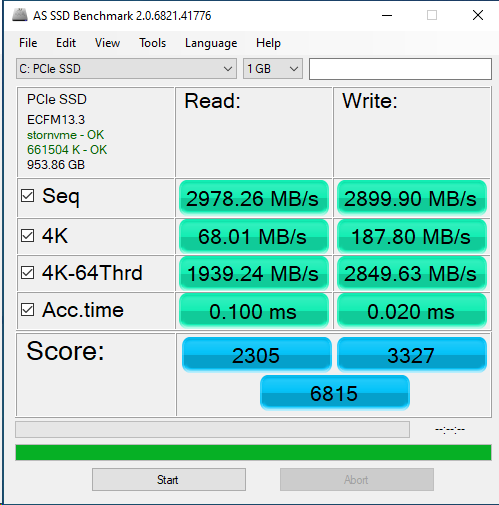


Anyway, wanna see how fast it really is? Next page and onwards into the review then. The unit follows a smaller M.2 2280 form factor (8cm) so it will fit on most ATX motherboards capable of M.2 just fine. The performance numbers of a proper SATA3 SSD offers these days are simply excellent, but with the more niche NVMe SSDs you can easily quadruple performance, which offers serious numbers. This item Inland Platinum 1TB SSD NVMe PCIe Gen 3. Really the only reason for the M2 SATA drives are for laptops or where space is at a premium. The SSD is a Non-Volatile Memory Express (NVMe 1.3) M.2 form factor SSD, it has been fitted with new Vertically stacked NAND TLC. Our AS SSD sequential read and write results pair nicely with Crystal Disk Mark. The performance will vary depending on volume size.

The specs are great but will this unit deliver what it claims? SSD is based on that familiar Phison's PS5012-E12 controller and of course, has been fitted with 64-layer TLC written NAND from Toshiba. Heck, they even offer 5 years warranty. The TBW (TeraBytes Written-the total amount of data that a company is willing to guarantee can be written to the drive) ratings of 350/600/1200/2000 for the 256GB/512GB/1TB/2TB drives seem quite up there as well. Yes, that is darn inexpensive. Addlink is claiming numbers that run into the 3400 MB/s Write Speeds and up to 3000 MB/s for these M2 SSDs, at 11 cents per GB. The S70 is available in four flavors: the 1TB version I tested (currently $114 on Amazon), a 256GB model, a 512GB model and a 2TB model (currently $245 on Amazon). How good (or bad) is a low priced M2 SSD bought from Amazon? We received an email from Addlink claiming they offer an SSD (Addlink S70 1TB NVMe PCIe 3x4 SSD) that often gets compared being 'a Samsung EVO 970's nightmare' in relation the price of just 114 USD for 1TB. Most modern SATA SSDs have a difficult time writing more than 400 MB/s so it's not like the Inland NVMe 128GB is a step backwards compared to drives shipping today, but some older SATA SSDs can write sequential data a little faster.Addlink S70 1TB NVMe PCIe SSD (3400 MB/s - 1TB -114 USD)Įnthusiast M.2.Class SSD performance for a mainstream price Sequential write performance scales up to 800 MB/s on the 256GB but only 400 MB/s on the 128GB. Sequential read performance comes to 1,500 MB/s and 1,300 MB/s. The system communicates with it through PCIe bus and connects to the built-in PCIe controller of the chipset or processor, so the signal transfer is as simple, precise as point to point, that offers you a pleasant high-performance transfer experience, without a bit of lag or delay. The Inland NVMe 256GB has a shallow performance drop off but the 128GB model steps over a cliff. MP34 M.2 PCIe SSD supports the latest NVMe1.3 protocol. The same drive also delivers up to 220,000 read and 150,000 write IOPS. The Inland NVMe 512GB tops the list with 1,550 MB/s sequential read and 950 MB/s sequential write speeds. Performance varies by size with the highest coming from the largest capacity. Get NVMe SSD performance, with incredibly fast USB3.2 Gen 2 Type-C interface, Inland Premium External SSD 1TB provides transfer speeds up to 1000MB/s read and 900MB/s write speeds, much faster than traditional external HDDs. The Inland NVMe does come in 128GB, 256GB, and 512GB. Description of Original Problem: My C: is a GIGABYTE AORUS NVMe Gen4 SSD (1TB M.2 2280 PCI-Express 4.0). Make sure this fits by entering your model number. There isn't a 1TB option at this time, so gamers looking for a large capacity, but budget-friendly, NVMe drive will have to look elsewhere.
#INLAND PREMIUM 1TB DISKMARK PROFESSIONAL#
Inland Professional is only courting a small portion of the market with this release.


 0 kommentar(er)
0 kommentar(er)
